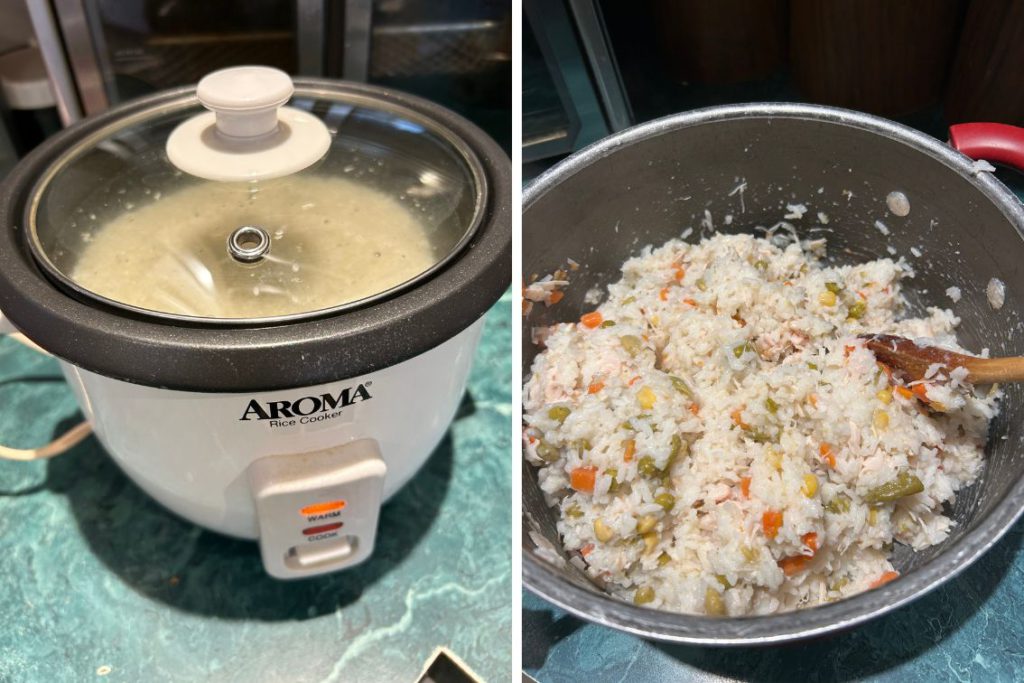Welcome to Homesteading For Women – we hope you enjoy all our tips and tricks for homestead women! Please note that we use affiliate links and ads to generate income at no cost to you.
Are you worried about what’s really in commercial dog food these days? I was too. That’s what led me down the path of making homemade dog food—and I’ve never looked back. What started as a simple way to help my Chihuahua with her health turned into a weekly routine that keeps all my dogs happy and healthy.
In this post, I’ll walk you through exactly how I make dog food in a rice cooker, what ingredients I use, how I store it, and why it’s worth the little bit of effort. Your pups will love it—and you’ll feel better knowing exactly what they’re eating.
Why I Started Making My Own Dog Food
Years ago, one of my sweet Chihuahuas started having seizures. It was terrifying. After trying everything the vet suggested, I decided to take a closer look at her food. I started making her meals from scratch with simple, wholesome ingredients. The results were almost immediate—her seizures became less frequent and eventually stopped.
After she passed, I went back to commercial food for a while. Even the more expensive brands. But then another one of my dogs started showing the same symptoms. That was my wake-up call. I’ve been making homemade food ever since—over seven years now—and I’ve never regretted it.
Why I Use a Rice Cooker
At first, I made big batches of dog food on the stovetop, usually while cooking dinner. It worked, but it took time and attention. Then a couple of Christmases ago, my son gifted me a rice cooker—and it changed everything.
Now, I can throw the rice in, push a button, and walk away to take care of chores. It cooks perfectly every time, and I can focus on prepping the other ingredients. It’s one of my favorite kitchen tools now, especially for dog food.

My Simple Homemade Dog Food Recipe
This is the basic recipe I make each week for my five small dogs. It’s simple, affordable, and their tails start wagging the minute they smell it cooking. Over the years, I’ve added a few extra ingredients to help round out the nutrition, and it still takes very little effort—especially with my rice cooker doing most of the work.
Ingredients:
- 3 cups white or brown rice
- 2 frozen chicken breasts (or leftover turkey or canned chicken)
- 1 cup frozen mixed veggies (peas, carrots, green beans – no onions!)
- 1 cooked egg, chopped
- 1 tablespoon plain pumpkin purée (optional – great for digestion)
- 1 teaspoon olive oil or coconut oil
- ½ teaspoon crushed eggshell powder or dog-safe calcium supplement
- Splash of the broth from cooking the chicken (for flavor and extra minerals)
- Light sprinkle of salt and pepper (optional)
How I Make It:
- Start by adding the rice and water to your rice cooker. I use 3 cups of rice and fill to the line, then turn it on and let it do its thing.
- While the rice is cooking, boil your chicken breasts in a large pot of water until fully cooked through. Save the broth—it’s full of good nutrients and flavor.
- Chop the cooked chicken into small, bite-sized pieces and toss it back in the pot. Add the frozen veggies, the chopped boiled egg, a spoonful of pumpkin, and a bit of the chicken broth. Let that simmer together for about 10 minutes to soften everything and blend the flavors.
- Once the rice is finished, stir it into the chicken and veggie mixture. Add the oil and your calcium source, then mix well.
- Let it cool completely before portioning. I feed about 2–3 tablespoons per dog, twice a day. Store the rest in airtight containers in the fridge for up to a week.
That’s it! No preservatives, no mystery ingredients—just real food made with love. You can also freeze portions in silicone trays or bags if you want to prep ahead. The dogs love it!
Ingredient Swaps I Use
One of the great things about this recipe is how flexible it is. I’ll often use what I have on hand:
- Canned chicken when I’m in a pinch
- Turkey dark meat (leftovers after Thanksgiving are perfect)
- Canned vegetables if I’m out of frozen
- Ground beef or pork occasionally, if I find a good sale
Just make sure to avoid anything toxic to dogs—no onions, garlic, grapes, raisins, or high-fat meats like sausage.
Broth-Saving Tip
If you cook chicken often, don’t toss that broth! I pour leftover broth into a dedicated ice cube tray, freeze it, then store the cubes in a zip-top bag. It’s perfect for soups, stews, or adding a little extra flavor to my dog food mix.
Recycling Chicken Cans for Homestead Animals
Canned chicken may be pricey, but I always save those little cans. They’re perfect for wintertime when I need small, swap-out containers for my chickens or rabbits. When it’s freezing outside, I can quickly replace their frozen bowls with clean ones, thanks to my stash of recycled cans.
And yes—my dogs love to lick them clean before I wash them!
Are My Dogs Getting Enough Nutrients?
This is something I researched a lot in the beginning. While the food I make is full of real, wholesome ingredients, I also give my dogs daily supplements to make sure they’re getting all the essential vitamins and minerals they need.
You can find multivitamins specifically made for dogs, or talk with your vet about what’s best for your breed and size of dog. I also occasionally add:
- A spoonful of plain yogurt
- A bit of cottage cheese
- A dash of olive oil or fish oil
These little additions go a long way for coat health and digestion.
How I Store Homemade Dog Food
After the food cools, I divide it into smaller containers and keep them in the fridge. It’ll last 5–7 days easily when sealed tightly.
You can also freeze it in portions if you’re making a larger batch. I like using freezer-safe silicone trays to make portion-sized blocks I can pop out and thaw when needed.
How Much Does It Cost?
Surprisingly, it’s not much more than good quality dog food—and sometimes it’s cheaper!
Here’s a rough breakdown for a week’s worth of food (for 5 small dogs):
- Rice: $1.00
- Chicken (2 breasts): $4.00
- Frozen veggies: $1.50
- Total: around $6.50 for the week
Compare that to some of the grain-free, high-protein dry dog food bags that run $30+ for a couple of weeks, and you’ll see the savings add up.
Pros and Cons of Making Your Own Dog Food
Pros:
- You control what goes in
- You can adapt recipes to your dog’s needs
- You avoid fillers and preservatives
- It can improve your dog’s health
- Strengthens your bond with your pets
Cons:
- Takes more time to prepare
- You’ll need to add supplements or research nutrition
- It can cost more if you use premium meats
- Requires proper storage and handling
For me, the pros far outweigh the cons. Once you get into a routine, it really doesn’t take much time at all.
Frequently Asked Questions
Can I use brown rice instead of white rice?
Yes! Brown rice is great and offers more fiber. Just make sure your rice cooker can handle it and adjust cooking time as needed.
Can I add eggs or sweet potatoes?
Absolutely. Scrambled eggs, boiled eggs, and cooked sweet potatoes are all great additions that my dogs love.
How do I know my dog is getting enough nutrients?
Start with a balanced base recipe and then use a dog-safe multivitamin. You can also rotate ingredients for variety and check with your vet if you’re unsure.
What about picky eaters?
You’d be surprised how fast even picky eaters warm up to homemade food. Mine lick their bowls clean!
Making dog food in a rice cooker has been a game changer for me. It’s quick, affordable, and gives me peace of mind knowing my dogs are eating real food made with love. If you’ve ever thought about trying it yourself, go for it—you might never go back to store-bought again!
If you try this recipe, I’d love to hear how it works for your pups. Drop a comment or send me a message on Facebook!
You Might Also Enjoy:
Soft Pumpkin Dog Treats: The Best Homemade Dog Biscuit Recipe
House Smells Like Dog When It’s Humid? Here’s My Solution
How To Repel Ticks Naturally! And It’s Cheap and Works GREAT!
- How I Make Dog Food in a Rice Cooker (And Why I’ll Never Go Back to Store-Bought) - July 17, 2025
- Why I Love My Bread Machine (And You Might Too) - July 15, 2025
- 3 Must-Have Tools for the Beginner Homestead Kitchen - July 11, 2025

